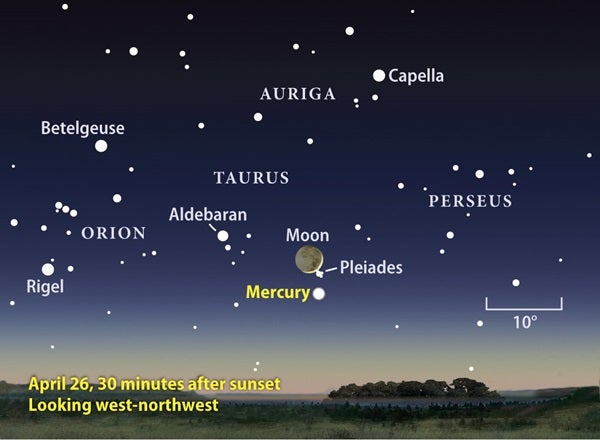In mid-April, Mercury sets more than 80 minutes after sunset. During the month’s final 2 weeks, Mercury closes in on the spectacular Pleiades star cluster, also known as the Seven Sisters.
Astronomy magazine Contributing Editor Raymond Shubinski encourages everyone to observe Mercury. “Mercury is a major planet in our solar system,” he says. “Everyone who’s interested in the sky should see it at least once. And when the planet’s bright like it is now, all it takes is a quick trip outdoors.”
Don’t miss a stunning sight around 9 P.M. local daylight time April 26 when a crescent Moon joins Mercury and the Pleiades in the deepening twilight. The Moon lies 2° (about 4 Moon-widths) above the cluster, and Mercury sits 3° (6 Moon-widths) below the cluster. The Moon’s dark portion will be clearly visible, illuminated by sunlight reflected from Earth, known as earthshine. Binoculars will provide the best view.
On April 29, Mercury lies about 3 Moon-widths south of the Pleiades. The Moon has climbed significantly higher and will lie in the constellation Gemini the Twins. Mercury has dimmed to the brightness of Aldebaran, the nearby reddish 1st-magnitude star in the constellation Taurus.
Viewing Mercury through a telescope remains challenging. The planet’s disk reveals little. Its low altitude in the sky and its visibility shortly after sunset leave observers viewing the disk while Earth’s atmosphere remains turbulent. The unsteady air yields unsteady images.
Still, Mercury’s appearance changes noticeably each evening. On April 9, 90 percent of the planet’s disk was illuminated. You’ll hardly notice it as less than full. The phase shrunk to three-fourths lit by April 15 and to half-phase April 21. By month’s end, Mercury will display a 27-percent-lit crescent.
- Podcast: How to see Mercury, the Moon, and the Pleiades together in the night sky — Astronomy magazine Senior Editor Michael E. Bakich helps you observe this event. This podcast is available for FREE if you’re registered with Astronomy.com. Registration is easy and only takes a few seconds. Registered members can leave comments on our Editors’ Blog, submit images to and comment on images in our Online Reader Gallery, participate in our Reader Forums, receive our free weekly e-mail newsletter, and more!
- Interactive star chart — StarDome will give you an accurate map of your sky. This tool will show you where to look to find the Moon, Mercury, and the Pleiades in your night sky.











